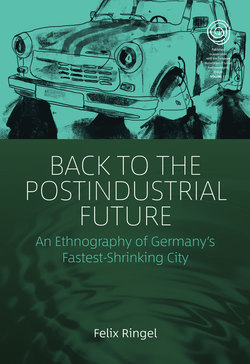Читать книгу Back to the Postindustrial Future - Felix Ringel - Страница 8
На сайте Литреса книга снята с продажи.
Preface
ОглавлениеEthnography in Hindsight
Writing ethnography is akin to time-travelling: we are bound to a present that has already gone. Anthropological data is hence always out of date; its ‘best before’ date is reached at the end of fieldwork. But thought needs time, and time does not stop to elevate the representational concerns of a social scientist. Consequently, we keep on travelling back in time, trying to capture what was there. However, studying the relations to the future of my informants and their hometown might tempt author or readers to evaluate which past predictions prove true. This book argues we should avoid such temptations. We have to take the present we explored as what it was: a short stretch of time, during which we have shared life with the people we study. This book aims to take the reader back to Hoyerswerda in 2008 and 2009 and to account for the conditions and problems that were prevalent then. These problems might resemble the ones ‘currently’ important in Hoyerswerda, but to establish whether they are the same, is impossible.
To capture the present I encountered in sixteen months of fieldwork is hard. There is simply not enough space to represent the ethnographic material that I assembled during this time in one singular argument. In hindsight, I have not captured this particular present or period in its entirety, and my argument restricts itself to matters of time, particularly of the future. Since the future was on everybody’s mind then, I am assured that my informants will appreciate why it takes centre-stage now. Sadly, this means I had to leave many things out. Therefore, the readers will not read about Waltraut Skoddow’s delicious asparagus salad or the resounding laughter of elderly women from the Cultural Factory’s knitting club. They will not be taken at night to the spooky emptiness of an abandoned eleven-storey apartment block awaiting demolition. They will not stand on its roof, seeing the lights and straightforward lines of the New City’s impressive modernist architecture. They will not see the numerous pieces of art that decorate the interiors of so many apartments in the city or sit around a dinner table with one of my host families, discussing matters of the day, tidings from the local newspaper or plans for the weekend. There is also not enough space to see the many sculptures from the socialist past displayed throughout the city, or the local zoo, another true accomplishment from the same historical period. We will not enjoy ourselves in absurd costumes at the local anarchists’ ‘Coke, Puke, Communism II’ (Koksen, Kotzen, Kommunismus II) party or dance the conga line with the seniors’ club Spätlese e.V. after its annual fashion show, where the models were recruited from among their own active crowd. We will not go on a wolf tour with Stephan, join a few of the remaining miners on their way to work much too early in the morning, or carefully cycle home after a splendid Weinclub-dinner at the best restaurant in town on a bike exhibiting a sticker advocating the renovation of a house in the city centre with the slogan (in English) ‘Born to Survive’. We will not stop for a beer in front of the Schlucki drinks market, listen to a private Gundermann concert by young singer-songwriter Florian in district 5 or visit Moni on her lovingly cared for garden plot that is part of what is still called the ‘Bright Future’ (Frohe Zukunft) allotments. We will not stand on stage with the grandmother who, in lieu of her grandchild, awaits the introductions for the ceremony of the former socialist confirmation equivalent: her grandchild will arrive the next morning from her family’s new West German home, where the East German Jugendweihe is not celebrated.
As I focus on drastic postindustrial decline and the presumed loss of the future, the readers will not be introduced to the ‘normal’ small city lives that people, too, live in Hoyerswerda. They will be taken to moments of conflict and argument, of critical commentary, creative work and existential negotiations. These moments do not allow much time for silence and introspection. But for the sake of the argument of this book, they are important to attend to because they help to underline that the everyday life of a shrinking city is in many ways not normal. The future looms over it and demands thought, care and reflection. This book documents this postindustrial urban community’s response to a presumed loss of the future and the new kinds of social relations this loss creates.
